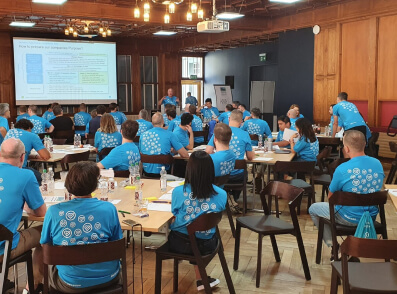Despite the great promise these technologies offer, however, their widespread adoption is being hampered by a fundamental problem—a lack of meaningful economic evaluation. Insurers, healthcare providers, and policymakers are increasingly looking for tangible evidence that these technologies are actually delivering a return on investment. Without solid data demonstrating eHealth cost-effectiveness, securing funding and scaling these technologies will remain an issue.
In this article, we’ll examine the problems associated with measuring ROI of eHealth interventions, the solutions that are emerging, and how platforms like dacadoo’s Digital Health Engagement Platform (DHEP)may be the answer the industry is looking for.
Proven methods that deliver meaningful results
Key takeaways:
- Health interventions need to prove their value to secure funding and scale.
- Cost-benefit analysis (CBA), cost-effectiveness analysis (CEA), and cost-utility analysis (CUA) are key frameworks to help ROI evaluation.
- Quantifying outcomes, such as QALYs, allows direct comparisons of different health programs.
- dacadoo’s DHEP provides measurable savings, with a 5% healthcare cost reduction, verified by a University of Groningen study.
What is cost-benefit analysis in healthcare?
Quantifying health outcomes in monetary terms is a problematic process, with the complexities and ethical considerations involved making it extraordinarily challenging. That said, cost-benefit analysis in eHealth is an indispensable part of the equation—certainly, when you consider the substantial amounts of investment often required to develop eHealth technologies.
In a bid to help determine economic value, a number of key frameworks are commonly used:
Cost-Benefit Analysis (CBA)
This method involves quantifying both the costs and benefits of an intervention in direct monetary terms. It provides a comprehensive view of whether the benefits outweigh the costs, making it a key tool for decisions involving resource allocation. CBA allows stakeholders to compare various interventions by expressing their outcomes in a common currency, providing a clear comparison.
Cost-Effectiveness Analysis (CEA)
CEA compares the costs of different interventions to achieve a specific health outcome, such as saving lives or preventing disease. It’s particularly useful when the benefits are difficult to monetize, focusing instead on an intervention’s efficiency at achieving a specific goal.
Cost-Utility Analysis (CUA)
CUA extends CEA by incorporating quality of life into the analysis, using metrics like Quality-Adjusted Life Years (QALYs). This allows for comparisons across various health programs by considering both the quantity and quality of life gained. QALYs provide a standardized measure that accounts for the impact of health interventions on well-being as well as longevity.
What are the challenges in measuring eHealth costs and benefits?
As mentioned, evaluating the effectiveness of eHealth interventions can be complex. The varied nature of these interventions, ranging from simple mobile apps to sophisticated telehealth systems, makes it difficult to establish consistent metrics. What’s more, quantifying intangible benefits, such as time saved, improved access, or peace of mind, adds another layer of difficulty—how much is a good night’s sleep worth in dollars?
In addition to this, the impact of eHealth extends beyond direct healthcare costs. It affects a wide range of stakeholders, including patients, providers, and payers, each with their own set of costs and benefits. This broad vista of variables complicates the evaluation process, making it hard to extrapolate findings from one study to another. When you factor in the rapidly evolving nature of technology on top of this, even if you arrive at meaningful evaluations, they can quickly become outdated.
Proven methods to evaluate eHealth interventions
It’s not all bad news though. Despite the inherent challenges in the process, effective digital health evaluation methods do exist.
Randomized controlled trials (RCTs)
RCTs isolate eHealth intervention impact by randomly assigning participants to treatment or control groups, minimizing bias and establishing clear causal links. For example, an RCT can definitively assess a diabetes management app’s effectiveness by comparing outcomes against standard care.
Observational studies
While lacking RCT control, observational studies provide real-world insights into eHealth interventions. They track long-term impacts across diverse populations, revealing trends that remain hidden in controlled settings. For example, an observational study can analyze telehealth’s impact on rural care access, considering factors like patient satisfaction.
To gain a clearer picture of performance, evaluations consider the full spectrum of costs—not just the immediate outlays for equipment and software, but the ripple effects on productivity, healthcare use, and even travel. Similarly, intervention benefits extend beyond simple metrics like mortality and morbidity—they encompass the nuanced improvements in quality of life, often captured through measures like QALYs.
Using these comprehensive, data-driven approaches we can construct effective healthcare cost savings strategies that transform the potential of digital health into tangible, measurable outcomes.
How validated platforms like dacadoo can help
Given the complexity of the evaluation arena, technologies like dacadoo’s Digital Health Engagement Platform (DHEP) offer a major advantage. dacadoo employs a scientifically-backed approach that integrates behavioral science with state-of-the-art technology to drive sustained user engagement. Our DHEP, featuring the dacadoo Health Score, allows users to make healthier lifestyle choices through gamification, personalized insights, and social features.
The efficacy of dacadoo’s platform isn’t just theoretical—it’s backed by compelling evidence. An independent study conducted by the University of Groningen revealed a tangible 5% reduction in healthcare costs among dacadoo users. Notably, the study found that consistent usage, rather than short bursts of intense activity, proved to be the key driver of these cost savings, highlighting the importance of nurturing long-term, habitual engagement.
Overcoming common evaluation barriers with DHEP
dacadoo’s DHEP addresses several common evaluation barriers. It simplifies data collection by providing real-world metrics and automated tracking of health improvements. This allows insurers and healthcare providers to monitor the cost implications of their interventions in real-time.
Beyond this, the platform’s scalability across diverse populations and regions further heightens its value, allowing for broad implementation and impact assessment. Integrating smoothly with existing systems through APIs, dacadoo delivers a simple and efficient evaluation process that makes insurance cost-benefit analysis, for example, far more meaningful.
Moving healthcare forward with dacadoo

With an aging world population and increased strains on healthcare systems, eHealth investment is more essential than ever—as is the accurate ROI needed to make meaningful decisions. Platforms like dacadoo not only streamline the economic evaluation process, but deliver real healthcare cost savings and better health outcomes. For insurers and providers, we’re a major step forward in health economics that opens the door to greater savings, improved engagement, and better well-being for everyone involved.
To find out more about dacadoo and how our DHEP can help your healthcare business make better decisions, you can contact us here.






















